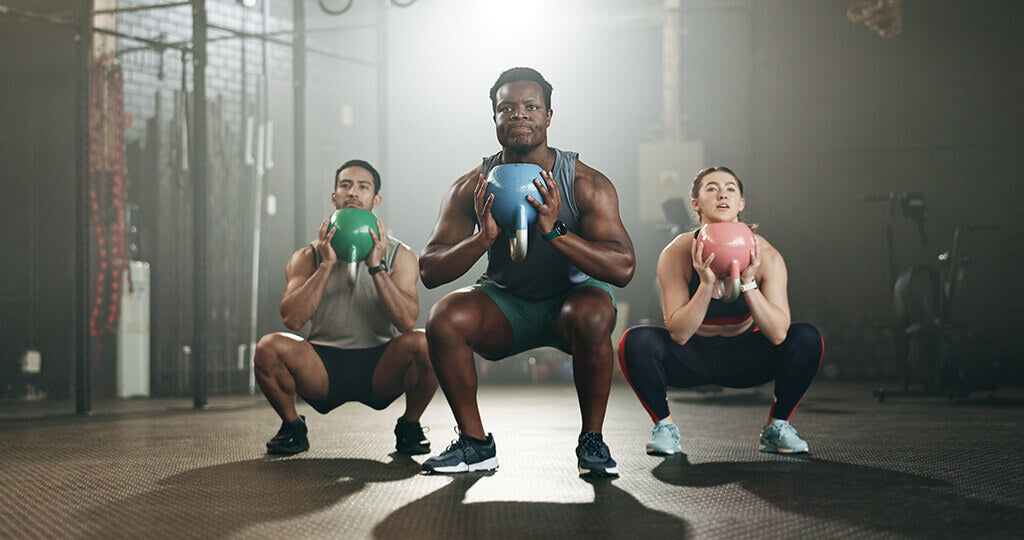What is cross training? It’s an exercise philosophy that champions variety, combining strength, endurance, and flexibility workouts to craft a balanced fitness routine. This holistic approach not only curtails overuse injuries but also keeps your training fresh and progressive. Here, we’ll unpack the how and why of cross training, offering actionable insights for anyone looking to elevate their fitness game.
Key Takeaways
- Cross training diversifies your workout, targeting various muscle groups to boost overall fitness, prevent injuries, and break performance plateaus.
- It offers mental benefits by introducing new skills and challenges, keeping workouts engaging and preventing burnout and fatigue.
- Incorporating cross training requires balancing activities with your main sport and ensuring adequate recovery to avoid overtraining and injuries.
Defining Cross Training

Cross training is a versatile approach to fitness that blends different exercises and sports to enhance overall performance, skill, and balance. By combining cardiovascular exercise, strength training, and flexibility exercises, it creates a varied fitness program that promotes full-body conditioning and reduces the risk of injury. One effective way to cross train is by alternating between various activities, ensuring a well-rounded workout routine.
Whether you’re a runner seeking to improve your agility or a cyclist wanting to build strength, cross training for cyclists offers the perfect mix of workouts to help you achieve your goals.
The Purpose of Cross Training
First and foremost, athletes leverage cross training as a multi-faceted fitness development tool by participating in various exercise routines, including those targeting the upper body. It allows them to work on underused muscles, maintain fitness without risking injury, and stay well-rounded for peak performance.
Additionally, the varied nature of cross training aids in:
- Recuperation from strenuous primary sport activities, thereby enhancing health and extending an athlete’s career
- Challenging the body in new ways, helping athletes break through performance plateaus
- Leading to improved athletic capabilities
Different Types of Cross Training
The blend of cardiovascular, strength, and flexibility workouts in cross training fosters all-around fitness. Engaging in sports as a form of cross training can enhance:
- agility
- reaction time
- power
- speed
This keeps your fitness routine engaging and fun, ensuring a steady ride towards your goals.
For instance, cross country skiing is a beneficial cross-training activity for cyclists to consider as an alternative to their primary sport. This low-impact, high-intensity workout offers a full-body workout and mimics the forward movement of cycling, making it a fantastic off-season training option.
Benefits of Cross Training for Runners and Cyclists

Cross training becomes a potent instrument for runners and cyclists to enhance performance, ward off injuries, and introduce mental diversity. It leverages the strength of different sports and workouts to build stamina, improve muscle balance, and enhance overall fitness.
Improved Performance
Performance in your primary sport can witness a significant uplift from cross training. For runners, cycling helps build strength in muscles that are complementary to those used in running, leading to overall strength improvements. Additionally, specific swimming strokes can strengthen the core, which significantly impacts cycling performance and endurance.
On the other hand, incorporating cycling into a runner’s training routine enhances stamina and endurance without overstraining leg muscles. Regular strength training is crucial for improving muscular power and endurance while also reducing the risk of injury for both runners and cyclists. These workouts should be carefully chosen to enhance certain fitness aspects, like speed or endurance, based on the athlete’s primary sport goals.
Injury Prevention
A key advantage of cross training is its role in preventing injuries. By engaging diverse muscle groups, including complementary muscles, it reduces the likelihood of strain and overuse injuries. Regular cross-training activities enhance muscle coordination, stability, and flexibility, preventing injury-inducing imbalances.
Moreover, athletes can adapt their cross-training routines during an injury, allowing other body parts to be exercised while the injured area rests, avoiding aggravation. This balanced approach to athletic development serves as a preventative measure against overtraining syndrome.
Mental Refreshment
In addition to its physical advantages, cross training serves as a mental respite. It introduces mental refreshment and varied motivational factors for both runners and cyclists by providing new challenges and skill development. The varied cross-training activities help athletes avoid burnout and fatigue, keeping motivation high and goals achievable.
Activities like swimming can provide a mental detox and a psychological break from the primary training focus, helping to preserve the physiological foundation of endurance while refreshing the mind. It breaks the monotony of regular training and stimulates enthusiasm, ensuring consistent and robust training efforts.
How to Incorporate Cross Training into Your Routine

The thought of weaving cross training into your regimen might appear intimidating. However, with a bit of planning and a mindful approach, it can be seamlessly integrated into your workout schedule, bolstering your fitness journey.
Balancing Cross Training with Primary Sport
Maintaining an equilibrium between cross training and your central sport is a nuanced task. It involves:
- Paying close attention to your body
- Maintaining a training log
- Ensuring adequate recovery time
- Varying training throughout the year
- Scheduling adequate rest
This is crucial to prevent overtraining and running performance decline.
Moreover, strength training should not follow hard endurance sessions immediately and should be planned no sooner than 24 hours after, or alternatively, on the same day as easier workouts. Strength training is a recommended aspect of cross-training for athletes to build muscles that are less used in their main sport, preventing fitness plateaus.
Sample Cross-Training Schedule
Creating a cross-training schedule with a variety of training activities and designated rest days can maximize fitness benefits and prevent overuse injuries. Here’s an example of a cross-training schedule:
- Monday: Endurance training (e.g. swimming)
- Tuesday: Strength training with weights
- Wednesday: Yoga for flexibility
- Thursday: Balance exercises
- Friday: Endurance activity (e.g. cycling)
By incorporating different types of exercises throughout the week, you can work on different aspects of fitness and prevent boredom. Don’t forget to include rest days to allow your body to recover.
In addition to a variety of activities, high-intensity interval training (HIIT) can be incorporated once a week to improve cardiovascular health and explosive strength. Saturday could be a light activity day or a complete rest day, followed by a longer, more intense session on Sunday, such as a long-distance run or bike ride.
Essential Cross-Training Workouts for Runners and Cyclists

Let’s delve into the essential cross-training workouts for runners and cyclists. Here, we’ll focus on strength training exercises and cardio workouts that target specific muscle groups and enhance your endurance and performance in your primary sport.
Strength Training Exercises
Strength training exercises form a pivotal component of cross training. For runners, doing squats, deadlifts, and step-ups target key muscle groups, improving their strength and endurance. Additionally, bodyweight exercises like air squats, planks, push-ups, and pull-ups support endurance training and upper body strength when equipment is not available. Core strength and aerobic training complement these workouts, enhancing overall fitness and performance.
For cyclists, strength training offers enhanced pedal power, greater leg strength, and reduced injury risk. Incorporating cycling workouts into your routine, with exercises such as leg presses, which mimic the pedaling motion, along with plyometrics like box jumps, can significantly improve cycling performance.
Cardio Workouts
Any fitness regimen is built fundamentally on cardio workouts. Low-impact workouts like swimming not only preserve endurance required for cycling but also serve as a full-body exercise improving flexibility and offering light resistance training. Swimming also enables athletes to maintain cardiovascular endurance through workouts that fit easily into weekly schedules and provide variability in heart rate training.
In addition, high-intensity interval training (HIIT) can enhance cardiovascular fitness and endurance, offering an alternative to traditional workouts that may become monotonous over time.
Tips for Choosing the Right Cross-Training Activities
Selecting appropriate cross-training exercises can considerably transform your workout regimen. By assessing your personal goals and needs and experimenting with different activities, you can select workouts that are both enjoyable and effective.
Assessing Personal Goals and Needs
Establishing your core fitness objectives and evaluating potential areas of improvement is the initial phase in determining suitable cross-training exercises. Understanding personal physical limitations is equally important to tailor cross-training activities that align with an individual’s capability to achieve fitness goals.
Consideration should be given to select cross-training activities not represented in one’s primary sport. This approach assists in gaining diverse fitness benefits and avoiding overemphasis on familiar movement patterns. Moreover, considering personal enjoyment in the selection of cross-training activities is key to sustaining long-term commitment to the training regimen. Some examples of cross-training activities include:
- Swimming
- Cycling
- Yoga
- Pilates
- Weightlifting
- HIIT workouts
- Dance classes
If you use your phone while cycling, make sure you have a top quality charging phone case and mount. This will allow you to use your apps, listen to music, track your ride, and much more without the worry about your phone battery dying.
By incorporating these activities into your training program, you can improve your overall fitness, reduce body fat, and prevent boredom or burnout.
Experimenting with Different Activities
Just like variety adds zest to life, so does experimentation in cross training. Participating in various sports as a form of cross-training can bring the fun of competition and skill development, offering unique challenges that stimulate physical and mental growth.
On days not dedicated to specific workouts, any physical activity, including everyday tasks like housecleaning or gardening, can support maintaining a baseline of fitness. For cyclists, incorporating cross-training activities like pilates can address specific movement skills with isolated, focused exercises that complement cycling training.
Common Cross-Training Mistakes to Avoid
Despite cross training’s potential to revolutionize your fitness regimen, certain common blunders should be avoided. Overtraining and neglecting recovery can hinder progress and increase the risk of injuries.
Overtraining
Athletes, particularly the enthusiastic ones, frequently fall into the trap of overtraining. It can lead to a decline in athletic performance and significant recovery time that may span weeks or months. Signs of overtraining include:
- Persistent muscle soreness
- Feeling run down
- Inability to maintain previous performance levels
- Quality sleep disturbances
- Increased frequency of illnesses or injuries
To prevent overtraining, it’s essential to heed the body’s signals such as unusual muscle soreness, progressively incorporate cross training by following the 10 percent rule, and perform strength training focused on weaker muscle groups to avoid imbalance and potential injury.
Neglecting Recovery
Another frequent oversight in cross training is the disregard for recovery time. Adequate rest, including a complete day off each week, is vital to prevent overtraining and should be incorporated into an athlete’s routine. Light physical activity on rest days, as opposed to complete inactivity, can support the recovery process while taking a break from high-intensity workouts.
The frequency of rest days should be tailored to an individual’s recovery needs, with newer athletes possibly benefiting from more frequent rest days. Ignoring rest or recovery days in a training regimen increases the risk of injuries and can lead to burnout, compromising long-term fitness goals.
Summary
In conclusion, cross training is a powerful tool for runners and cyclists, offering a diverse range of benefits, including improved performance, injury prevention, and mental refreshment. By carefully selecting and balancing cross-training activities with your primary sport, you can reach new heights in your fitness journey. Remember, the key to successful cross training is variety, balance, and, most importantly, listening to your body. So why not mix up your routine and experience the transformative power of cross training?
Frequently Asked Questions
What is cross-training in cycling?
Cross-training in cycling refers to engaging in physical activities other than cycling, such as running, Pilates, gym work, and yoga, to improve overall fitness and prevent injury. It can be a valuable addition to a cyclist's training routine.
What's the difference between cross-training and strength training?
The main difference between cross-training and strength training is that strength training focuses on building muscle and increasing overall strength, while cross-training involves participating in different types of physical activities to enhance overall fitness and reduce the risk of injury. So, if you want to target specific benefits, go for strength training, but for overall performance improvement, cross-training is the way to go!
How can cross training improve my performance?
Cross training can improve your performance by building strength in complementary muscles, enhancing stamina and endurance without straining your primary muscles. Try incorporating different types of exercise to see improvement in your performance.
How does cross training help in injury prevention?
Cross training helps prevent injuries by engaging diverse muscle groups, enhancing muscle coordination, stability, and flexibility, and allows your body to rest and recover while still maintaining fitness levels. It's a great way to reduce the risk of getting injured during your workouts.




Leave a comment
This site is protected by hCaptcha and the hCaptcha Privacy Policy and Terms of Service apply.